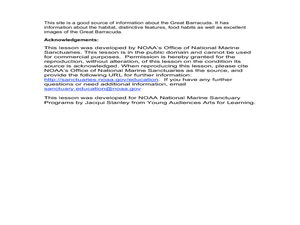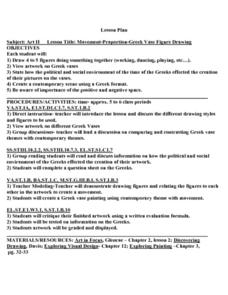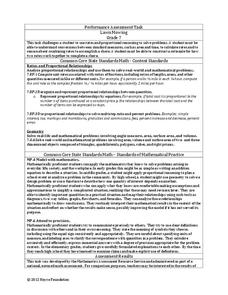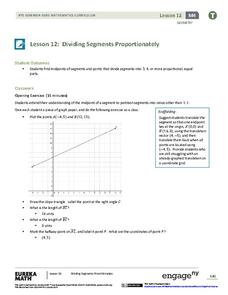Curated OER
Clay Portrait Project
Students discuss facial proportions and mix colors similar to flesh tones. In this art lesson plan, students draw and paint a portrait and then translate this image into a 3D form using clay.
Curated OER
The Stained Glass Window
Learners use centimeter rulers and the attached worksheet containing a scale drawing of a stained glass window. The actual measurements of the stained glass window are given, and students are asked to find the actual measurement of the...
Curated OER
Using Ratios
Students study the Golden Ratio and its relationship to Renaissance artists. After exploring proportions and ratios used by Renaissance artists, students create a mix of ten variations of color paint, and record the ratios of primary...
Curated OER
Blazing the Trail
Learning about proportions through measuring and mapping distances is the focus of this real-world math activity that doubles as an activity. Mathematicians complete a course designed to measure and map locations in order to put the...
Curated OER
Paper Pool
Students explore ratio and proportion, GCF, and LCM. In this middle school mathematics lesson plan, students play an interactive Paper Pool game that provides an opportunity to increase their understanding or ratio, proportion, GCF, and...
Curated OER
Silhouettes and Interiors
Students create a multimedia piece that integrates drawing and collage. Students learn about metacognition and the discovering of self through genres of art and literature by using these steps: inspiration, brainstorm, application,...
Curated OER
Map Adventures
Students explore the relationship between a scale drawing and actual distance. In this mapping lesson, students use an amusement park map to determine distances and what they would be like in real life.
Curated OER
The Bouncing Ball
Students use the scientific method to conduct an experiment to test how a ball bounces. In this inquiry-based physical science and scientific method lesson, students drop a ball from specified heights and record the rebound, then record...
Curated OER
One Size Fits All?
Learners describe the differences between an estimate and a guess. They create reasonable estimates based on comparison and activities. Students explain how estimation is helpful in showing the relative size on a scale. They also...
Curated OER
The Great Barracuda
Students explore oceanography by researching the great barracuda. In this animal life lesson, students read several vocabulary terms dealing with ocean life and examine a drawing of a barracuda. Students examine the many...
Curated OER
Solving Equations Using Two Operations
Need more detail in showing your class how to solve two-step equations and proportions? This lesson plan outlines the steps young mathematicians need to solve simple equations and check their results.
Curated OER
Movement-Proportion-Greek Vase Figure Drawing
Students begin the lesson plan by drawing figures doing different activities. As a class, they view artwork on Greek vases and discover how the political situations affect the drawings on the vases. They draw their own scene to place...
Noyce Foundation
Photographs
Scaling needs to be picture perfect. Pupils use proportional reasoning to find the missing dimension of a photo. Class members determine the sizes of paper needed for two configurations of pictures in the short assessment task.
Noyce Foundation
Lawn Mowing
This is how long we mow the lawn together. The assessment requires the class to work with combining ratios and proportional reasoning. Pupils determine the unit rate of mowers and calculate the time required to mow a lawn if they work...
Balanced Assessment
Scale Charts
Develop scales using tables. Pupils complete charts to show equivalent scale factors before using the completed tables to determine the sizes of scale drawings. They finish the lesson and demonstrate their understanding by completing a...
EngageNY
Dividing Segments Proportionately
Fractions, ratios, and proportions: what do they have to do with segments? Scholars discover the midpoint formula through coordinate geometry. Next, they expand on the formula to apply it to dividing the segment into different ratios and...
California Education Partners
Linflower Seeds
How does your garden grow? Use proportions to help Tim answer that question. By using their understanding of proportional relationships, pupils determine the number of seeds that will sprout. They create their own linear relationships...
EngageNY
End-of-Module Assessment Task: Grade 7 Mathematics Module 4
Asses the class to determine their knowledge of proportional relationships involving percents. Class members work through the nine-question assessment with a variety of percent problems. The multi-step problems involve simple interest,...
National Research Center for Career and Technical Education
Salads
Lettuce talk for a moment about your culinary scholars; do they have what it takes to create a great salad? Show them the finer points of salad preparation with a career and technology lesson that combines direct instruction, creativity,...
EngageNY
The Angle-Angle (AA) Criterion for Two Triangles to Be Similar
What do you need to prove triangles are similar? Learners answer this question through a construction exploration. Once they establish the criteria, they use the congruence and proportionality properties of similar objects to find...
Noyce Foundation
Which is Bigger?
To take the longest path, go around—or was that go over? Class members measure scale drawings of a cylindrical vase to find the height and diameter. They calculate the actual height and circumference and determine which is larger.
Carnegie Mellon University
Technical Sketching Worksheets
How do you create a technical drawing? Cover the basics of technical sketching with a few practice sketches of simple shapes. A technical sketching lesson introduces the proper precision measurement techniques. Pupils progress to draw...
Project Articulate
Textured Landscapes with Grant Wood
Explore the world of textured landscapes through the eyes of the famous artist, Grant Wood. Here is an elementary art lesson plan in which scholars learn about Grant Wood's life, view his work, draw their own textured landscape, and then...
Curated OER
Draw Me a Mammal!
Fifth graders illustrate at least three art elements in a drawing of a mammal they've read about with 100% accuracy. As a review, Bloom's Taxonomy questions are asked as they prepare to sketch something they pictured in the story they read.

























